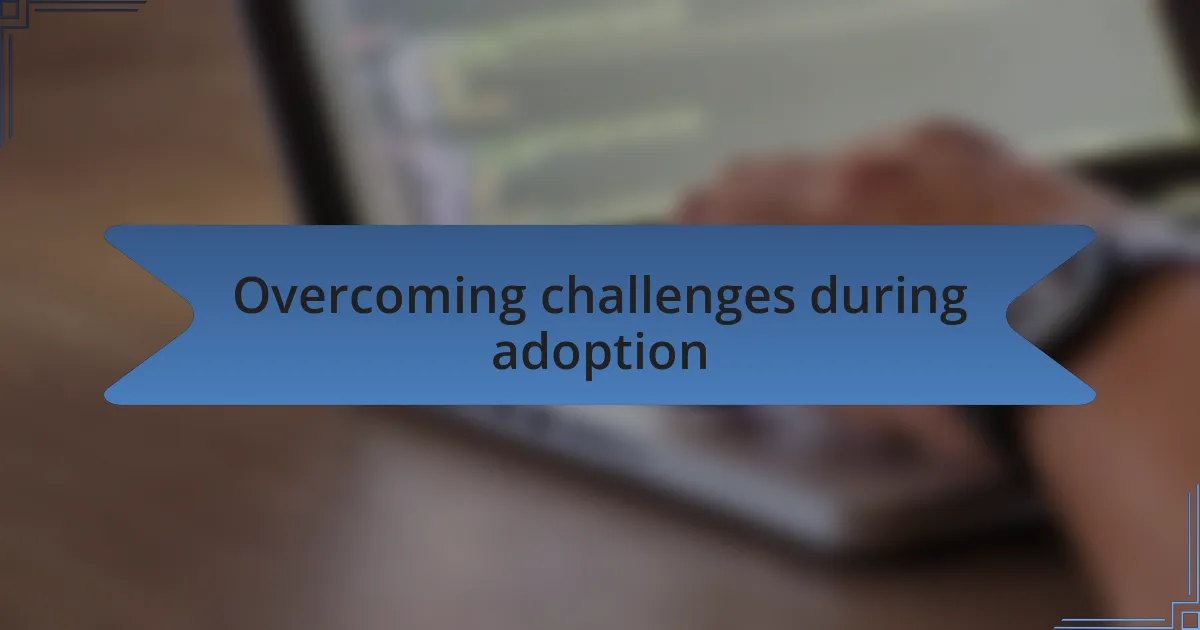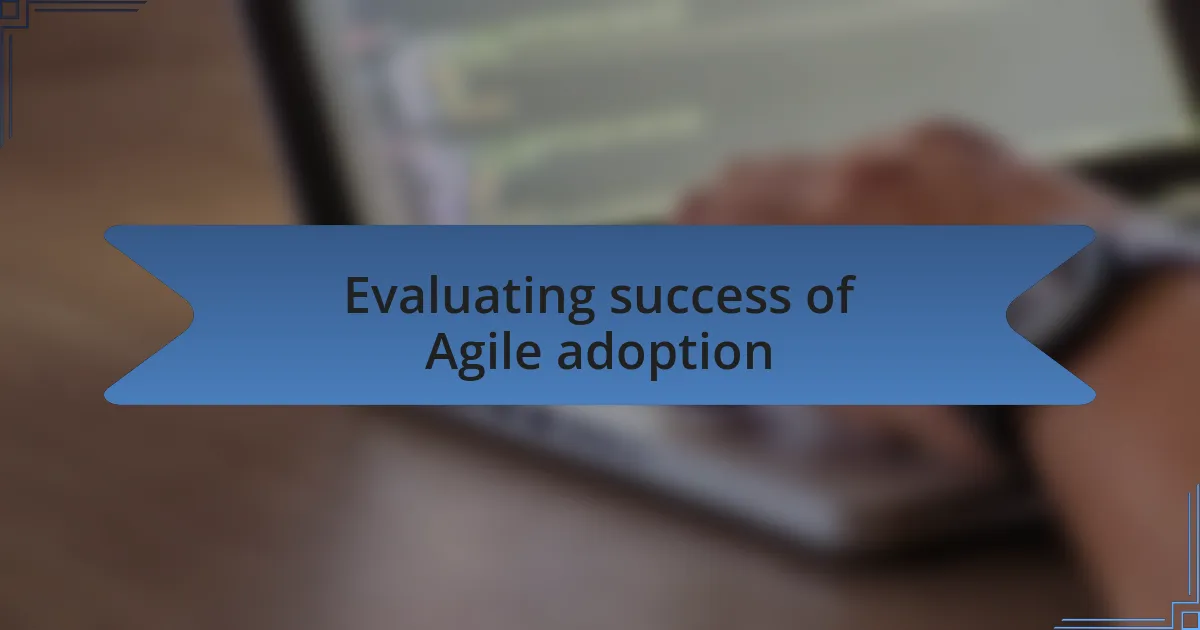Key takeaways:
- Agile methodology fosters a flexible, iterative approach to project management, prioritizing customer collaboration and frequent delivery.
- Key principles include self-organizing teams, a focus on collaboration over contracts, and regular reflection on processes for continued growth.
- Implementing Agile involves cultivating a culture of openness, providing thorough training, and setting clear expectations to guide the transition.
- Success in Agile adoption is measured not just by metrics, but also by team morale, confidence, and an inclusive environment where every member feels valued.

Understanding Agile methodology
Understanding Agile methodology means embracing a flexible approach to project management that prioritizes collaboration and customer feedback. I remember the first time my team opted for Agile; it felt like stepping into uncharted waters. There was so much excitement mixed with uncertainty.
At its core, Agile promotes iterative development, which allows teams to adapt to changes quickly. I vividly recall a sprint where unexpected changes from a client shifted our priorities. Instead of panicking, we gathered for a quick huddle, realigned our goals, and continued flowing smoothly. Isn’t it incredible how a well-structured framework can turn challenges into opportunities?
Moreover, Agile emphasizes delivering working software frequently, which fosters a sense of accomplishment among team members. I found that each time we completed a sprint, it created a mini celebration in our workspace. Not only did we build better products, but we also strengthened our team dynamics. How often do we get that kind of motivation in traditional approaches?

Key principles of Agile practices
Agile practices are fundamentally built around a few key principles that shape how teams operate. One of the most significant is the focus on customer collaboration over contract negotiation. I can still remember how a simple meeting with a client transformed our project direction. Instead of getting hung up on what was initially agreed upon, we listened to their new needs and adapted our course, ultimately delivering a product that aligned better with their expectations. Isn’t it fascinating how listening can lead to such impactful changes?
Another essential principle is the importance of self-organizing teams. I’ve been part of teams where roles were clearly defined, but those structures often stifled creativity. When we moved to Agile, the emphasis shifted to individuals taking ownership of their tasks. I once saw a developer step up to lead a crucial part of a project, bringing fresh ideas to the table. This collective responsibility not only empowered team members but also spurred our innovation, making the work environment much more vibrant.
Finally, the principle of reflecting on our processes at regular intervals cannot be overlooked. During retrospectives, I learned the value of constructive feedback. At first, it felt a bit daunting to critically assess our work, but over time, I realized that these sessions were invaluable for our growth. It’s amazing how acknowledging our weaknesses and celebrating our successes led to tangible improvements. Have you ever noticed how reflection can illuminate paths for progress that might otherwise go unseen?

Preparing my team for Agile
When I set out to prepare my team for Agile, one of the first steps was fostering a culture of openness. I encouraged everyone to voice their concerns and ideas, creating an environment where feedback was not just welcomed but celebrated. I remember a team member who was initially skeptical about the Agile methodology; after a few open discussions, he became one of the strongest advocates for our new approach. It’s fascinating how a shift in communication can change an entire team’s mindset, isn’t it?
Next, I found that providing thorough training was critical. We organized workshops that focused on Agile principles and methodologies, and I even invited an Agile coach to share their experiences. Seeing my team engage with the material, asking questions, and sharing their own thoughts reminded me of how important it is to empower individuals with knowledge. Have you ever noticed how learning together can create a unique bond among team members?
As the transition took shape, I realized setting clear expectations was vital. I outlined what Agile meant for our daily work, emphasizing the roles of sprints and stand-ups. This structure helped the team understand the rhythm of Agile and provided clarity amidst the initial chaos. Reflecting on this, I can’t help but appreciate how setting a solid foundation allowed us to build on our Agile journey with confidence. It’s true what they say: a clear path can inspire the greatest adventures.

Overcoming challenges during adoption
Adopting Agile brought its fair share of challenges, one of which was resistance to change. I vividly recall during a sprint planning meeting when a seasoned developer expressed frustration over the shift to self-organized teams. His apprehension was palpable, and it got me thinking: how often do we cling to the familiar, even if it no longer serves our best interests? To address this, I initiated one-on-one conversations to understand his concerns and demonstrate how Agile could lead to greater autonomy and productivity.
Another hurdle was the varying levels of experience and understanding within the team. Some members embraced Agile right away, while others struggled to grasp its nuances. I remember a particularly enlightening moment when a newer team member shared her confusion during a retrospective. It dawned on me that facilitating a ‘safe space’ for vulnerability could transform learning. How empowering it felt to watch team members lean into their questions, transforming uncertainty into collective growth!
Finally, maintaining momentum was a challenge I hadn’t fully anticipated. Early enthusiasm can fizz out if not nurtured. I decided to celebrate small wins regularly, reminding everyone of our progress and reinforcing the Agile principles we were adopting. There was one occasion when we completed an iteration ahead of schedule, and we took a moment to acknowledge that achievement together. Wasn’t it incredible how gratitude could invigorate our drive? This experience taught me that fostering ongoing recognition is essential in maintaining an Agile mindset and sustaining team morale.

Evaluating success of Agile adoption
Evaluating the success of Agile adoption can feel like navigating uncharted waters. One tangible way I gauged our progress was through regular feedback loops. During our retrospectives, I would ask the team to rate their satisfaction with workflow improvements and communication. I noticed that as we integrated Agile more deeply, the scores began to rise, and the discussions became more constructive. It was a clear sign that we were on the right track.
However, numbers alone don’t tell the whole story. I found that the most revealing evaluations came from the team’s emotional responses. I still remember the day when a junior developer shared how much more confident she felt contributing ideas during stand-ups. Her words stuck with me: “It’s like my voice actually matters now.” That realization highlighted a fundamental change in our culture, showing me that Agile was not just about processes, but about creating an inclusive environment where every team member felt valued.
Ultimately, success isn’t solely measured by delivery rates or sprint velocity. I learned to pay attention to the team’s overall well-being as a vital indicator of our Agile adoption’s effectiveness. When I noticed team members actively supporting one another, celebrating each other’s achievements, it hit me that we had grown as a unit. Isn’t it amazing how the human aspect—trust, collaboration, and shared pride—can be the most profound outcome of embracing Agile?